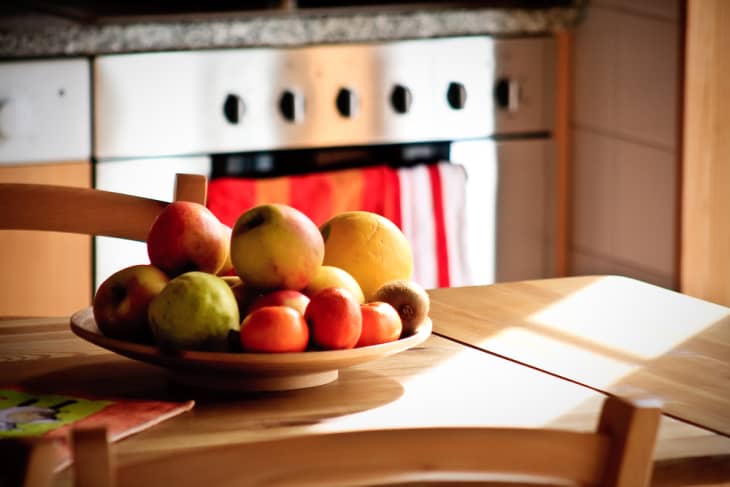What Ever Happened to Decorating with Fake Fruit?

When you peek back at real estate photos of the ’90s and ’00s, you may notice a curious trend: fake fruit. Everywhere. While lemons were the most common pseudo-fruit offender, sneaky homeowners could be found filling bowls with pears, grapes, and bananas—and don’t you dare take a bite. These overflowing bowls paired perfectly with the Tuscan fad that swept across America’s suburbs, but dreams of the lush Italian countryside aren’t the only reason this faux decor caught fire.
Fake fruit had its heyday in the height of the mid-aughts, back when picture-perfect McMansions were the most desirable thing.
“Homeowners sought after that ‘perfect home’ look, and they wanted it 24/7, not just when the fruit was ripe and the plants were green,” says Leigh Spicher, the National Director of Design Studios for home builder Ashton Woods.
In 2005, America was still recovering from the horror of 9/11. Real estate was booming. Is it a stretch to say fake fruit let us forget about the inevitability of death? Fake lemons never rot. Faux bananas never brown. Plastic grapes never fell from the vine. A bowl of gorgeous, bountiful, pristine fruit promised prosperity in perpetuity.
But it also looked really, really fake.
“It kept getting stuck in our teeth,” jokes Los Angeles interior designer Mark Cutler. The “Oops, I just bit into a fake pear and now I need a new tooth” scenario seems plucked from our wackiest rom-coms, but that awkward moment did, on occasion, happen.
Forcing our friends to shell out for dental work isn’t fake fruit’s only flaw. Consumers are increasingly seeking authenticity in their lives, and a bowl of plastic fruit doesn’t make the cut.
“There is a swing to the natural in all its forms,” says Cutler. “Fake fruit is a victim to this swing. A bounty of overflowing fruit no longer has meaning to us, and so the need to have that as a permanent display simply doesn’t exist anymore.”
With mindful living on the rise, “Homeowners want their decor to match their personalities and lifestyles,” says Spicher. “What does a bowl of fake oranges say about a homeowner versus a bowl of real apples or a glass container of nuts?”
To many, that bowl of fake produce says exactly that: You’re fake, and your home is fake, too. In the age of authenticity, that thought may drive you bananas. Especially when real materials are increasingly available and increasingly affordable—not to mention edible.
“I say, down with fake fruit,” says designer Erica Leigh Reiner. “The globalization of trade and products helped decrease the price of real materials, making them more mainstream. This made fake materials a faux pas—pun intended.”
Stuff a bowl with apples for a fun burst of color, or set out a nut bowl that suits your seasonal fancy. (Almonds for summer, chestnuts for winter!) But even if manufacturers savvy up and create more-realistic (but still fake) fruit, Reiner doesn’t think the trend’s coming back.
“You don’t get that same impact on your other senses, like texture and smell,” she says.
That doesn’t mean the trend is totally finito. “Occasionally, you can find interpretations of fake fruit that isn’t trying to be fake fruit,” says Bradley Odom, the owner of Dixon Rye. “I recently saw a bundle of all-white lemons, oranges, and apples, and it was a compelling statement in a bowl on a kitchen island. But I would stay away from the ’70s version of fake fruit. Some things just belong in the past.”
Expect to see fruit reconceptualized in nontraditional mediums: a stone pear or wooden apples. These styles are still très chic when used “with a simple approach, like as a paperweight on a favorite stack of books,” says Odom.
Uniformly, designers recommend veering away from plastic mimicry. Not only is it outdated and inauthentic, but this style harms the environment.
“We all need to be purging our homes of all plastic to help protect the ocean,” Odom says.
Instead of choosing fake fruit, Spicher recommends looking in your cabinets: normal staples like nuts, apples, dried beans, or cherries can all serve as decoration. Don’t want to keep temptation on hand? Fill a glass bottle with orange juice and preserved orange peels.
“It adds the same color in a cool bottle,” Spicher says. “Plus, you may use it to cook.” Gorgeous decorations—with a genuine purpose? There’s nothing fake about that.